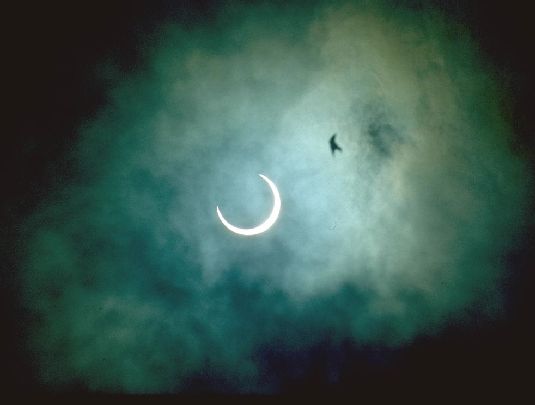Credit & Copyright: Olivier Staiger
Explanation:
A
lunar eclipse can be viewed in a leisurely fashion.
Visible to anyone on the night side of
planet Earth (weather permitting), totality
often lasts an hour or so as the moon glides through the Earth's shadow.
But
a solar eclipse is more fleeting.
Totality can last a few minutes only
for those fortunate enough to stand in the path of the
Moon's shadow as it races across
the Earth's surface.
For the April 29, 1995 annular solar eclipse,
photographer Olivier Staiger
was standing in Macara, Ecuador under partially cloudy skies.
Just before the maximum annular eclipse phase he recorded
this dramatic moment as a bird flew near the sun.
The next solar eclipse,
on
June 10, will also be an annular one.
Partial phases will be
visible from eastern Asia, the
Pacific Ocean and much of North America.
Very accurate
predictions
of eclipses have long been possible.
1999 2000 2001 2002 2003 2004 2005 2006 2007 2008 2009 2010 2011 2012 2013 2014 2015 2016 2017 2018 2019 2020 2021 2022 2023 2024 2025 |
Январь Февраль Март Апрель Май Июнь Июль Август Сентябрь Октябрь Ноябрь Декабрь |
NASA Web Site Statements, Warnings, and Disclaimers
NASA Official: Jay Norris. Specific rights apply.
A service of: LHEA at NASA / GSFC
& Michigan Tech. U.
|
Публикации с ключевыми словами:
solar eclipse - eclipse - annular solar eclipse - Солнечное затмение - кольцевое затмение - частное солнечное затмение
Публикации со словами: solar eclipse - eclipse - annular solar eclipse - Солнечное затмение - кольцевое затмение - частное солнечное затмение | |
См. также:
Все публикации на ту же тему >> | |
